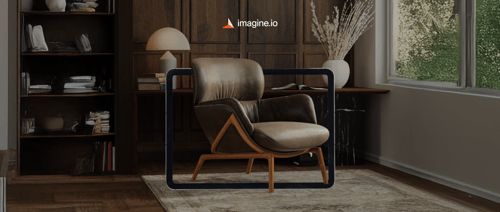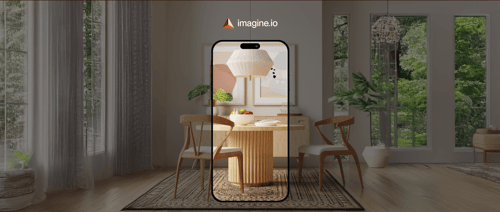Let’s Start with the Big Shift!
Not too long ago, eCommerce SEO was a game of keywords. Cram “sofa, couch, loveseat” into your product title, sprinkle a few long-tail tags, and you were good to go. But let’s be real—that playbook doesn’t work anymore.
AI has flipped everything. Tools like visual search, recommendation engines, and multimodal shopping interfaces no longer rely only on what you say about your products—they rely on what your products look like. So, here’s the hard truth: if your visuals aren’t high-quality, your products are practically invisible in today’s AI-driven shopping world.
Get the latest updates straight to your inbox.
By clicking sign up you'll receive occasional emails from imagine.io. You always have the choice to unsubscribe within every email you receive.
Why This Matters to Leadership Teams

I know what you’re thinking—why should C-level executives or VPs care about image quality? Isn’t that something for the creative team to worry about? Not anymore. Product visuals are now a revenue lever. Let me break it down:
-
Visual Search is Exploding
36% of consumers have used visual search, and over half say visual information is more important than text when shopping online. Not only this, billions of shoppers are already using Google Lens, Pinterest Lens, or Amazon’s image search.
Instead of typing “beige sectional sofa,” they just snap a picture. If your visuals aren’t sharp, consistent, and well-lit, AI either misclassifies your product—or doesn’t surface it at all. That’s not a design problem—it’s a lost sales opportunity.
-
Recommendation Engines Depend on Visuals
Amazon, Target, Walmart—they all run on “similar items” and “you may also like” carousels. The AI driving these features relies on visual data to match products.
If your visuals don’t clearly show fabric textures, finishes, or design details, your products won’t get pulled into those high-visibility recommendation spots. That means fewer cross-sells and lower average order values.
-
Image–text Alignment is Now a Ranking Factor
AI doesn’t just take your product description at face value anymore. It cross-checks visuals with text. If you list a “navy blue mattress cover” but the image looks black due to poor lighting, the algorithm marks it as inconsistent. And inconsistent listings get pushed down in rankings—no matter how good the copy is.
-
Multimodal AI is the Future
Imagine a shopper asking, “Show me a velvet sofa like this” while uploading a picture. AI blends voice + text + visuals to find matches. If your product visuals don’t align, you won’t show up. And if you don’t show up, you don’t sell.
Bottom line? Visual quality isn’t a creative nice-to-have—it’s a discoverability, visibility, and revenue issue.
What High-Quality Visuals Actually Do for Your Business
Let’s talk about outcomes. What do you, as a decision-maker, actually gain from better product visuals?
-
Improve Accuracy in Search
AI models analyze images at the pixel level. They detect colors, textures, shapes, even lighting. Poor-quality visuals risk misclassification. A beige fabric sofa can look white under bad lighting, a leather finish can be mistaken for vinyl. And once AI gets it wrong, your product disappears from the search results it should have appeared in.
High-quality visuals prevent that. They give AI the detail it needs to correctly identify and surface your product, so you show up exactly where your customers are searching.
-
Boost Product Recommendations
Product recommendations are the secret weapon of modern eCommerce. They account for a big percentage of sales on Amazon and other marketplaces. But here’s the kicker: AI bases those recommendations heavily on visuals.
If your images clearly show details like stitching, finishes, or patterns, your product gets pulled into “frequently bought together” or “similar items” feeds. That’s free exposure, powered by visuals. If they’re blurry or inaccurate? You’re simply invisible in that feed.
-
Build Shopper Confidence and Reduce Returns
Think about this from the customer’s point of view: if the product doesn’t look exactly like it’s described, they hesitate. Or worse, they buy and then return it when it arrives and doesn’t match expectations.
High-quality, accurate visuals build trust. As per a study, pages featuring 360-degree product views saw a 22% lift in conversions and a 35% rise in add-to-cart rates. This is because they give shoppers confidence that what they see is truly what they’ll get. That confidence translates into higher conversion rates and fewer returns—a straight boost to your bottom line. Here you must note that
-
Future-Proof Your Catalog for Multimodal AI
The way shoppers search is evolving fast. Multimodal AI—blending text, voice, and images—is already here. Google, Amazon, and Shopify are testing and rolling out features that let customers say, “Find me a rug like this, but bigger, in red.”
When this becomes mainstream, your product visuals will be the primary data AI uses to match that request. If your visuals aren’t optimized today, you’ll be scrambling tomorrow while competitors who invested early capture market share.
Best Practices: How Leaders Should Think About Visual Optimization
.png?width=1800&height=1120&name=Internal%20-%20Best%20Practices_%20How%20Leaders%20Should%20Think%20About%20Visual%20Optimization%20(1).png)
So, what can you actually do? Here’s the checklist leadership should push their teams toward:
-
Move Beyond Traditional Photography
High-quality photography is great, but it’s expensive and rigid. Consider photorealistic 3D renders—they’re scalable, flexible, and can show every detail from fabric textures to exploded views. Platforms like imagine.io make this easier by letting teams generate AR, lifestyle shots, and 360° spins directly from 3D models—no photoshoot bottlenecks.
-
Insist on Image–Text Alignment
Don’t let sloppy workflows create mismatches. Your visuals and descriptions must tell the same story, every time.
-
Show More Angles
AI doesn’t think in flat images—it learns from multiple views. 360° spins, zoomed-in textures, lifestyle scenes, and even exploded views give AI more to work with—and give shoppers more confidence.
-
Simplify Backgrounds
A cluttered background confuses algorithms. A clean, neutral background ensures AI correctly identifies the product—and customers focus where they should.
-
Adopt AI-Friendly Formats
The future is 3D and AR. Formats like WebP, GLB, and USDZ load faster, index better, and prepare you for next-gen shopping platforms.
Who’s Already Doing This?
- Amazon: Their AI-driven Style Feed heavily prioritizes visual clarity. Better images = better placement = higher visibility.
- Target & Walmart: Both now include image resolution, consistency, and accuracy in their marketplace content scores. Weak visuals directly hurt seller performance.
- Google Lens & Shopping: They’re image-first platforms. High-quality visuals determine whether you surface in visual SERPs at all.
If the biggest players in eCommerce are making visuals a ranking factor, it’s clear where the market is headed.
Wrapping it Up
Here’s the takeaway: keywords still play a role, but visuals are now the kingmakers. If your brand is serious about discoverability, you’ve got to start treating visuals as a strategic asset, not a creative afterthought.
Because in the AI-driven era, the brands that invest in sharp, accurate, scalable visuals will dominate. Everyone else? They’ll be left wondering why their products stopped showing up.
Want to see how leading brands are solving this right now? Get a free demo now and discover how our AI + 3D platform helps companies like yours create stunning, AI-optimized visuals at scale—without the cost and bottlenecks of endless photoshoots.


.gif?width=1296&height=1296&name=Untitled%20design%20(8).gif)




.png?width=500&name=How%20to%20Add%20a%203D%20Product%20Configurator%20to%20Your%20WordPress%20Website%20(Complete%20B2B%20Guide).png)
















%20(1).png?width=500&name=Why%20Exploded%20Mattress%20Views%20Matter%20(And%20How%20to%20Generate%20Them)%20(1).png)
.png?width=500&name=Best%20Shopify%20Product%20Configurator_%20How%20to%20Choose%20the%20Right%20One%20(2).png)
.png?width=500&name=Why%20Exploded%20Mattress%20Views%20Matter%20(And%20How%20to%20Generate%20Them).png)



.png?width=500&name=Best%20Shopify%20Product%20Configurator_%20How%20to%20Choose%20the%20Right%20One%20(1).png)







.png?width=500&name=How%203D%20Rendering%20Can%20Make%20or%20Break%20Your%20Industrial%20Design%20Pitch%20(1).png)








%20with%20Digital%20Twins%20and%203D%20Visualization.png?width=500&name=Optimizing%20Your%20Digital%20Asset%20Management%20(DAM)%20with%20Digital%20Twins%20and%203D%20Visualization.png)




.png?width=500&name=Styling%20Home%20Decor%20for%202025_%20From%20Global%20Influences%20to%20Playful%20Personalization%20(1).png)
